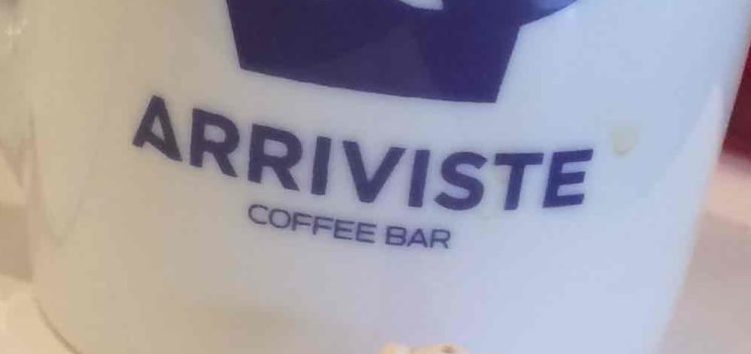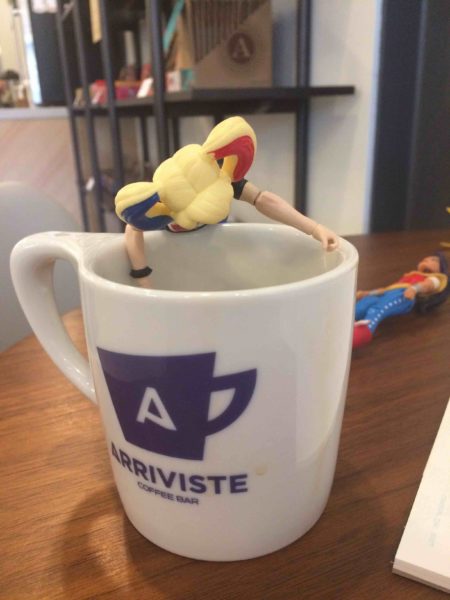
Many people equate “geeking out” with things like comic books and gaming. We here at GeekMom, however, know folks can geek out about anything from baking to football to knitting and lately, for a reason I can’t actually pin down, I’ve been talking to a lot of small business owners who have turned their geeky passion into small, independent shops (physical and virtual). This being a life goal for a large percentage of the geek population (myself included), I thought I’d pass along what I’ve learned. In our first installment, I talk to Kim Lopez, Arriviste Coffee Bar‘s managing partner, and one of Pittsburgh’s newest bean and leaf gurus, about where his passion for coffee and tea started, how it developed, and how he grew it into a career.
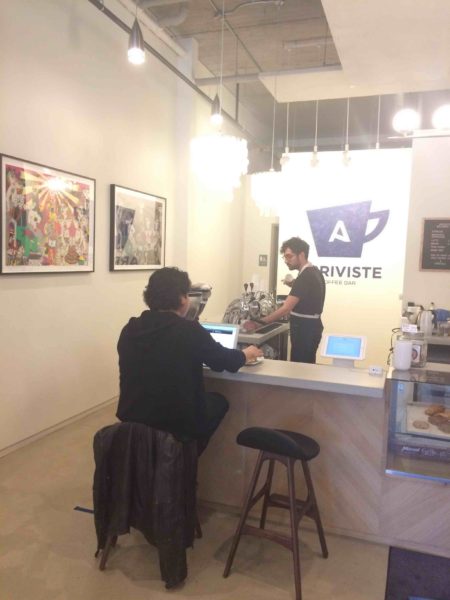
GM: Thanks for talking to me Kim! When did you first find yourself getting interested in coffee (and tea?) Was there any particular impetus? Did the interest come from someone else in your life or was it a chance encounter which led to an epiphany? Was it a gradual process of becoming engaged or was it a single “Holy crap!” moment?
KL: I’ve always been particular with my coffee, in the same way that I’m particular with food or wine, etc. I taught myself to cook when I was a teenager out of necessity! I was the kid who always wanted to eat out or at friends’ houses because I wasn’t impressed with the food at home… haha…
There was as specific moment when I realized that there was a whole different world of coffee I wasn’t aware of. A Brooklyn-based roaster was running the coffee kiosk at the Brooklyn Museum and they were serving a natural-processed Ethiopian which tasted of blueberry juice. That first taste of that kind of coffee made me jump into the rabbit hole.
GM: How did you go about learning more? Did you take classes or was it more of an independent project? What was your intended career and how did you fit your passion into your life with it? Do other close folks in your life share the coffee and tea passion or is it a solo thing? If it is solo, how did you manage it all with a career, family, and other interests?
KL: At first, it was just researching on my own, looking up which roasters or which coffee varietals were considered to be good, buying bags, and trying them out. Still, at this point, the interest in coffee was just a thing I did. It wasn’t until I moved to Pittsburgh from New York that I even though about making this interest a business or professional pursuit. Up to that point, I was working as a drug company consultant for a large firm. I quit my job since keeping it would’ve meant traveling extensively for work and that would have defeated the purpose of moving in with my fianceé who lived here. After as short period of trying to find anything even remotely related to what I used to do, I decided to give the coffee shop idea a go.

GM: When did you realize your geeky passion was becoming a career? Was it a quick transition or did it take a while? What was the process you went through to make it happen?
KL: The first thing I did was take a coffee business planning and barista training workshop in Portland (with Bellissimo Coffee Advisors aka American Barista and Coffee School). I need to do my research whenever I have a task to complete and I don’t like winging it, so I felt if I was gonna really give this thing a go, I needed to very quickly, and very efficiently, get some baseline knowledge about what I needed to get this idea off the ground and to actually make it a successful business.
After I got back from Portland, I began my business planning in earnest. Part of my research for business planning was to go around to all the “good” coffee shops, to taste their coffee, to see what worked and what didn’t, and really just make friends. I hadn’t completely fleshed out what my coffee shop concept was going to be–I just had a broad sense that I needed it to look and feel different while at the same time elevating the coffee quality to at least the level of Pittsburgh’s best shops if not hopefully better. But, it was also very important to me not to come across as a complete outsider who’s just ridden into town assuming the locals were a bunch of rubes who didn’t know what they were doing. That’s where the making friends came in. I was extremely fortunate that I became fast friends with the folks at Commonplace Coffee. A great community and a great bunch of people. They were very helpful from the very beginning and took me in with no hesitation or any sort of guardedness. They shared a lot of inside information about their business to help me understand the financials, inventory management, choosing a location, etc. They even let me work in one of their shops for an extended amount of time where I essentially got to train for free with some of the city’s best baristas.
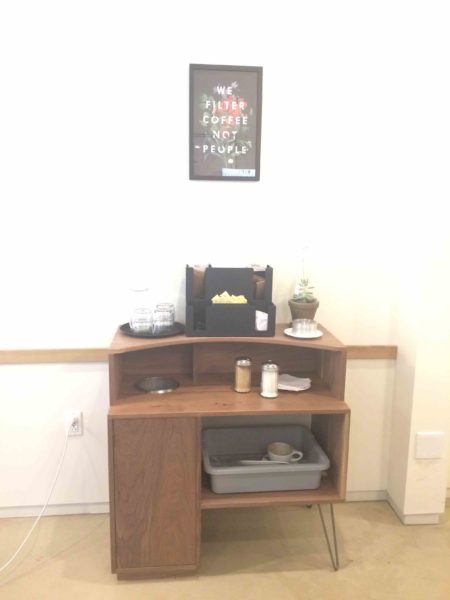
GM: What else do you geek out about? Now that coffee and tea are your career, have you picked up any new hobbies or gone back to old ones in your spare time? Do you have any spare time? Do you still love your geeky passion now that it’s your job?
KL: I’ve been an avid cyclist and triathlete since college, at one point competing at a decently high level for a non-pro and even coaching beginners. I almost got into coaching for real but medical school kind of got in the way. So yeah, I’m very into the more technical or scientific aspects of my sport–i.e. exercise physiology or bicycle technology. I’ve always preferred to train with very structured programs built on repeated tracking and testing of as much information as possible so I can “know” I’m improving. Of course, this was all before I opened the shop! I may have to dial back my expectations for the next few seasons but I am hoping to keep at it in some fashion. I’d also really love for other cyclists/triathletes/runners to use the shop as a hub for meeting up, getting a snack after training, etc.
Actually working in coffee now has ratcheted up my need to be really detail-oriented when it comes to making this stuff. Our team at Arriviste gets very “granular” about how to dial in recipes for everything we serve–from the priciest Reserve Lot pour-overs to our ready-to-go house drip. I personally have had to learn very quickly how to feel out a customer’s willingness to get in the weeds with me. A lot of times, a customer is as into this stuff as we are, but sometimes she just wants a coffee to go. By far, my favorite kind of customer interactions are with people who admit to knowing next-to-nothing about coffee but are willing to learn and try something new (ed note: which is how I started chatting with Kim in the first place). I absolutely love it when I see someone’s eyes light up and when they say that they never knew coffee could taste like that.
GM: You guys have several different brewing methods for coffee and tea you use at Arriviste. Talk a little bit about each one of them, tell us how you learned about them. Which are the most popular? Any idea why? Which are your favorite? Why?
KL: For coffee, we brew both espresso and filter coffee. Espresso is a traditional Italian method where hot water under high pressure is passed through very fine coffee grounds to extract the coffee. Filter coffee methods are older than espresso since it’s essentially just using some kind of physical barrier so the grounds can remain separated form the water as the water passes through to brew the coffee. We are the first coffee shop in Pittsburgh to use a Modbar espresso machine. It is essentially a traditional espresso machine that has been deconstructed into separate modules so that the big, hulking machine you’ll often see on top of coffee shop counters can be put away. It was primarily an aesthetic choice because I wanted a very open and clean look for my counter and I also wanted to increase the potential interaction between a barista and a customer. But aside from its looks, the Modbar has some fancy electronics that allow us to manipulate several brewing variables such as pressure, volume, temperature, and time much more precisely than a traditional machine.
“Pour-over” is a manual way of filter brewing to make, typically, a single serving of coffee (to distinguish it from “batch-brewing” where a large amount of coffee is brewed through a filter into a large airpot). In most speciality coffee shops, you’ll see a barista doing the pour-over with a kettle but we use a Marco SP9 machine at Arriviste. We’ve preset how much water we need, the infusion time, the grind of a particular coffee, and the dose of that particular coffee, then we flick the switch on the SP9 to begin the brewing process. The machine allows us to do two important things: 1) we don’t need to stand there and perform the whole process ourselves (which can take 3+ minutes), allowing us to complete other tasks while the pour-over is being done and 2) we’ve significantly decreased the variability in the pour-over, which can be very technique dependent between baristas and also sensitive to temperature fluctuations of the water. The SP9 produces a very consistent tasting coffee from cup to cup–we just need to get the recipe right and we’ll know it will taste the same all the time.
“Drip” and “filter” are interchangeable terms.
For tea, we do a traditional Chinese method called “Gong-fu” for our East Asian teas. This involves doing multiple, concentrated steeps of tea in small volumes and “stacking” them together to make a full serving (typically 4 steeps). Each steep is very short (a few seconds) so we don’t oversteep and get bitterness while at the same time getting a lot of flair from the tea. We do a traditional steep for our herbal and South Asian teas, which is just putting the loose-leaf tea in a bag and putting the bag in the cup or kettle of hot water.
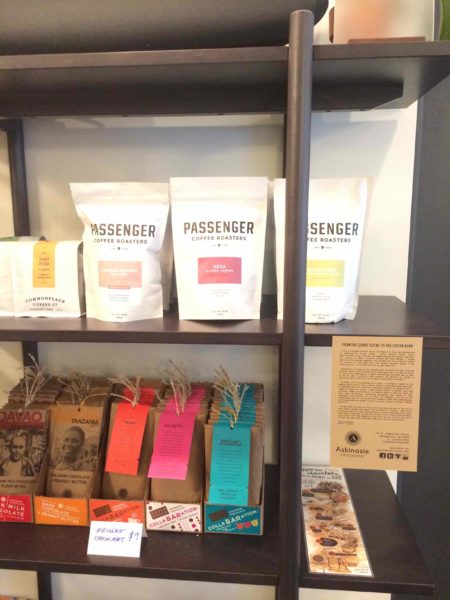
GM: What is your favorite coffee? Why? Tea? Why? How do you select for the shop? What do you have at home?
KL: The best tasting coffee I had is something we currently serve–the Monte Verde from Passenger Coffee (ed note: this is the coffee Kim recommended to me during the aforementioned initial conversation. It is. Ah-mazing). This coffee is a great example of how a coffee farm’s unique “terroir” can greatly impact the coffee’s flavor profile. The varietal of Monte Verde is called Gesha, which is an heirloom variety that originated in Ethiopia. But the coffee was grown in Columbia so the usual citrus fruit taste that you expect from Gesha is tempered by a balanced sweetness more typical of Columbian coffees. These coffees, that are complex and not one-note in their flavor, are the coffees I find most appealing. For tea, I think the staff favorite right now is the GABA Baked Oolong, also from Passenger. The tea has such a saturated sweetness that tastes of ripe plums and yeasty bread that customers find it hard to believe we don’t add any sugar to it.
GM: How did you decide on the look for the shop? The location? What have you learned since opening? Recommendations to folks who are looking to transform their geeky passion into a career? Would you recommend opening a storefront right away or is it better to start online? What are the best ways to let people know you’re there? Is there anything you’d do differently if you were going to do it again?
KL: I was very much influenced by a lot of other beautiful shops I’ve been to in other cities in the US and abroad. I knew that I wanted a minimal, clean, Scandinavian look which I’ve always been of fan of, especially mid-century Danish furniture, neutral palettes, light blonde woods. I did add some design elements from my country, the Philippines. Some of my lights, for example, are made of traditional Filipino materials. And, actually, even some of my furniture choices are reminiscent of how my grandparent’s living room looked when I was growing up. Shadyside as a location was not a hard decision to make given I knew the neighborhood was in need of a more quality-focused specialty shop (ed note: that is 100% true. I know because I live there). It was more a matter of actually being able to afford a space in Shadyside! I knew Walnut (Street) was out of the question but lucked out on my current space on Ellsworth (Avenue) where I have a lot of younger adults living nearby (target specialty coffee demographic) and a lot of complementary business like restaurants, bars, hair salons, etc.
Opening a storefront is a tricky thing. You have to be very confident that your business will have enough regular cash flow to support rent, of course, and making sure your lease is favorable to you as you grow your business. Almost the number one reason coffee shops fold, for example, is because they end up not being able to carry their rent or the rent increases too quickly or their lease terms run out before they can really get going. I would advise anyone to think long and hard about whether or not a true storefront is absolutely essential to whatever business they’re trying to start.
A neighborhood-driven business, like a coffee shop, has no choice but to market effectively to the people who live close by. Trying to advertise outside the neighborhood to try and make the shop a “destination” is probably not very cost-effective. Think about it: how far are you really willing to drive to a coffee shop vs, say, a restaurant? So, all of my marketing efforts are very local–from targeted Facebook ads limited to our zip code to contacting neighborhood publications to pounding the pavement myself to introduce myself to our neighborhood businesses. One really effective idea is to use buy-one-get-one cards for in-store use. Hand this out to people in the neighborhood and they become more likely to bring a friend to the shop while you’re at least covering your costs for the free drink. And, of course, in this day and age, you can’t get away from having a very active social media account if you have a business that is geared toward younger people. Post interesting content every day if you can. Learn to take good pictures (IG: arrivistecoffeebar, FB: @arrivistecoffee).
It’s too soon to really know what I would do differently Maybe if I could afford the investment and if I was more confident dealing with a real kitchen, I would have opened a cafe instead of a “just” a coffee bar.
GM: Who designed the logo? How much input did you have? Tell us about it. How important do you feel something like that is?
KL: My branding was done by a good friend (Isabel Roxas/Studio Roxas) who is a children’s book illustrator. She does this kind of work on the side for a handful of clients. I was very involved in the process. We started out with a mood board so that Isabel could get a sense of what kind of imagery, messaging, fonts, palettes, etc. appeared to me. We started out with 5 or 6 different approaches and quickly whittled that down to 2 or 3, continuing to refine until we landed on the current design. Again, like with so many things I decided on, the logo represents my own design preferences for solid palettes (in this case, indigo is my favorite color and was inspired by Japanese indigo fabric dyeing), simple clean looks (hence the straightforward type). Rule number one of coffee is branding… the brand needs to be immediately recognizable as being about coffee. So, in our case, the coffee cup is fairly obvious and of course we do say out loud that it’s a coffee bar. Being this “obvious” was even more important because of the non-English name I chose. “Arriviste” is French and literally means “someone who has just arrived.” But it is often used in a derogatory context as in “nouveau riche,” an upstart, someone not part of the establishment, or someone who is too ambitious. I decided on “Arriviste” as a nod to my immigrant roots and also because I want to signify that we are different from the establishment and that we have an ambition to hopefully be better than the establishment.
I can’t emphasize enough how important branding is. It really does say a lot about what your business stands for, who you are trying to reach, how serious or professional you are, and on and on. I think people either take it for granted and therefore the brand is unremarkable or, conversely, try to get too cute and then no one knows what the business is about.

GM: How do you decide who to hire to assist you? Do you want them to be as passionate as you are from go or have the same level of base knowledge or are you cool with people learning on the job? What’s your training program like? How formal is it? How do you get employees invested in your vision? Do you do things differently now than you did at the very beginning? What have you learned about the process? Advice for other folks trying to do what you’ve done?
KL: Th passion for coffee is a baseline expectation. I don’t need people who are going to make this a career but I need people who have high enough expectations for the quality level that they can produce. I need the kind of barista who will remake a drink because she wasn’t satisfied with how it came out. The ability to interact comfortably with customers also key. You can’t train personality, unfortunately, so anybody who is socially awkward or too quiet or low-energy is not gonna cut it even if they are technically very proficient. Related to this, I also look for people with a very positive attitude, someone who I know is going to be happy serving guests, someone who “gets off” on a satisfied customer. Specialty coffee shops already get a bad rap for being unwelcoming, condescending, snobbish environments. Even the way our shop looks already signals to people that we’re “that kind of shop.” So it’s super important we disperse that notion at the very first interaction we have with a guest.
This is not to say technical proficiency is not important. We’re just starting, so, unfortunately, I don’t have the resources to train someone from scratch. I can almost instantly tell someone’s skill level just by asking them to make me a cappuccino and it’s very easy for me to know if someone can get up to speed right away or if it’s going to be a struggle.
GM: If someone said do you, “I really love this thing and I want to make it my life,” what would you say? Do it? Don’t do it? Do it but…?
KL: I’ve gone through enough career transitions to know life’s too short to be doing something you’re miserable at. I’ve been very fortunate to have the ability to pursue my dreams and I understand that not everybody has the same resources I do. But if you really want something, you’ll make it happen. If it means starting out as a barista first, maybe doing a small kiosk or coffee cart instead of a full shop, so be it. Maybe you do your passion project on the weekends so that you can still pay the bills. Whatever your situation, if it’s really important to you, keep at it. Part of the fun is working towards your goals anyway!
GM: What color is your saber?
KL: Green for sure! Or maybe that purple Mace Windu one.
Arriviste Coffee Bar is located at 5730 Ellsworth Avenue, Pittsburgh PA. Phone: (412) 204-7320. Online at: arriviste.coffee.
